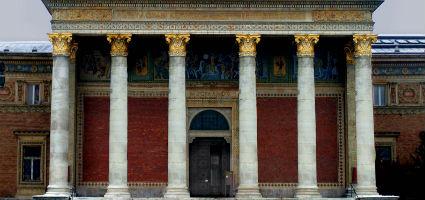2026. January 5. Monday
Kunsthalle - Budapest
 |
Address: 1146, Budapest Dózsa György út 37.
Phone number: (1) 460-7000, (1) 363-2671
E-mail: info@mucsarnok.hu
Opening hours: Tue-Wed 10-18, Thu 12-20, Fri-Sun 10-18
|
The exhibition has closed for visitors.
Museum tickets, service costs:
|
Ticket for adults
|
1200 HUF
|
|
|
Ticket for adults
(valid for the Kunsthalle and the Ernst Museum)
|
1400 HUF
|
|
|
Group ticket for adults
(from over 10 people)
|
800 HUF
|
/ capita
|
|
Ticket for students
(EU citizens from the age of 6 to 26 )
|
600 HUF
|
|
|
Ticket for students
(valid for the Kunsthalle and the Ernst Museum, 6-26 years of age)
|
700 HUF
|
|
|
Group ticket for students
(from over 10 people)
|
400 HUF
|
/ capita
|
|
Ticket for pensioners
(valid for the Kunsthalle and the Ernst Museum, 62-70 years of age)
|
700 HUF
|
|
|
Ticket for pensioners
(EU citizens from the age of 62 to 70)
|
600 HUF
|
|
|
Ticket for families
(1 adults + 2 children)
|
1800 HUF
|
/ family
|
|
Ticket for families
(2 adults + 2 children)
|
2400 HUF
|
/ family
|
The centenary of the sculptor Nándor Wagner’s birth (1922–1997) is being marked with a large-scale exhibition. Wagner’s in many ways extraordinary career can be divided into three periods and linked to three countries: Hungary, Sweden and Japan. As a result, he had to restart his artistic career virtually from scratch three times. The fountain sculpture titled Water-carrier Girl, one of his works from his fledgling years in Hungary and unveiled in Dunaújváros in 1955, can still be seen but his other monumental open-air sculptural works were only erected after his death thanks to the efforts of the Japanese-Hungarian Academia Humana Foundation Managing the Legacy of Nándor Wagner. In 1956 Wagner emigrated to Sweden, with numerous sculptures in public spaces attesting to the importance of this period. Among others, he erected a memorial to the Polish victims of World War II and modelled Martin the wild goose from Selma Lagerlöf’s children’s book The Wonderful Adventures of Nils. Together with the fine artist Akiyama Chiyo, his second wife, whom he met in Sweden, he relocated to Japan in 1969, where they built their own home and studio; this complex also contained a teahouse – reconstructed in our exhibition – combining elements of both Western and Eastern cultures. Wagner’s most well-known masterpiece, Philosophical Garden, was inaugurated on Gellért Hill in Budapest in 2011. This sculptural ensemble inviting everyone for meditation was conceived in the spirit of “better understanding each other”. With the representations of the founders of monotheistic religions and philosophers, Nándor Wagner sought to find the very thing that connects all of us, people. The replicas of sculptures displayed at the focus of our exhibition were made using the most advanced 3D printing technology and, this time too, invite visitors to come and think together.
